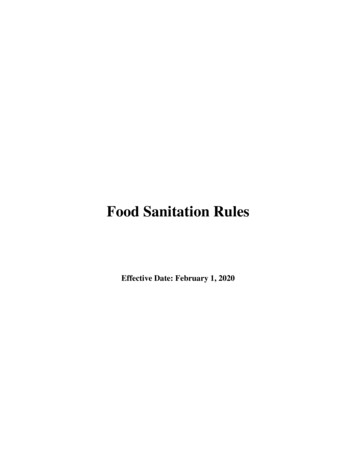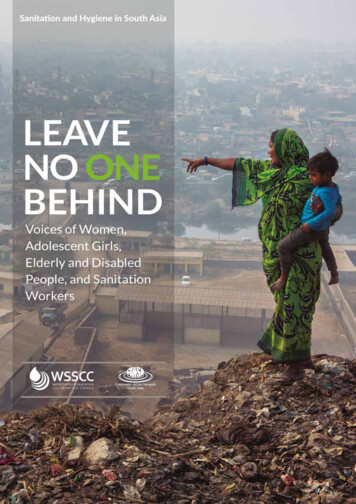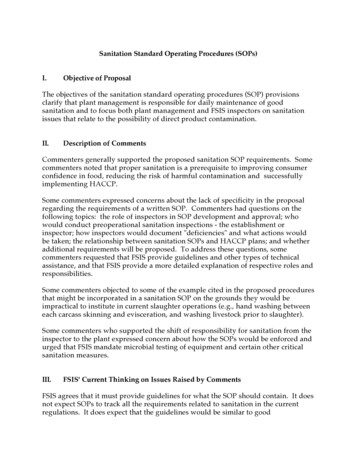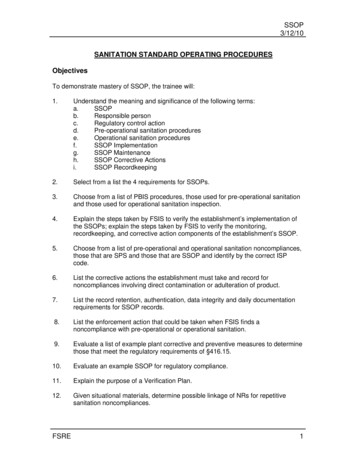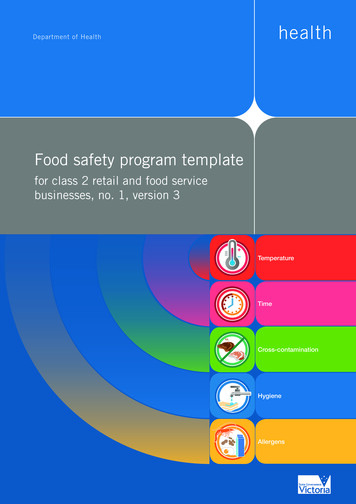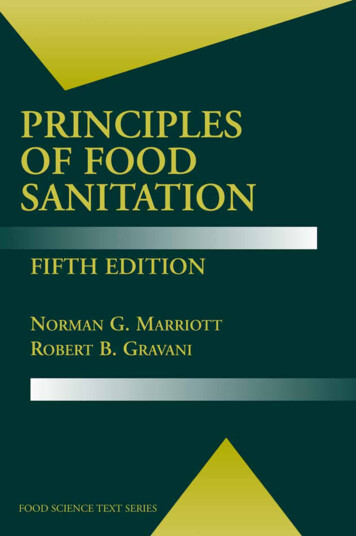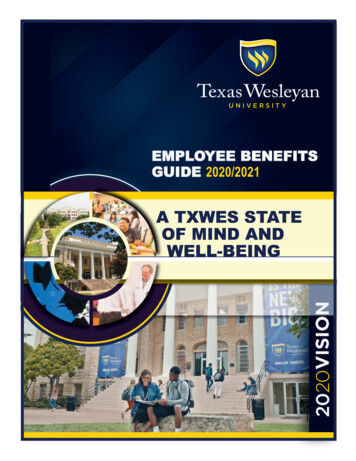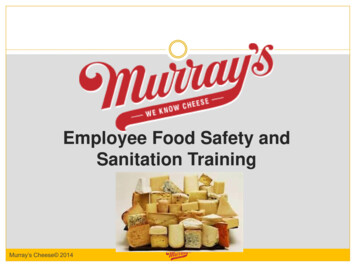
Transcription
Employee Food Safety andSanitation TrainingMurray’s Cheese 2014
Dangers in ContextMurray’s Cheese 2014
Why Is Sanitation Important? Essential to programs such as HACCP, ServSafe Most cases of foodborne illness are associated withsanitation problems. The complete sanitation process will reduce bacteriaand viruses that cause foodborne illness. Ensures quality and consistency of food products. Controls cross-contamination.Murray’s Cheese 2014
Results of Poor Sanitation Reduced shelf lifePoor quality productCustomer illnesses or deathMedical claims, lawsuitsLoss of jobFood recallsFines or other regulatory actionBad publicityLoss of customers and businessIt is estimated that there are 76 million cases of foodborne illnesses in the US everyyear, causing more than 325,000 hospitalizations and 5,000 deathsMurray’s Cheese 2014
Allergens Big 8 Allergens: Dairy,Eggs, Soy, Wheat, Fish,Shellfish, Tree Nuts,Peanuts cause 90% ofall allergic reactions Care must be taken toprevent crosscontamination betweenallergens containingproducts and otherproductsMurray’s Cheese 2014
Biofilms A hidden sanitation hazard Thin, not visible layer of food and bacteria that builds upon a surface Are a result of poor cleaning procedures Prevent cleaners and sanitizers from effectively reachingall surfacesMurray’s Cheese 2014
Common Pathogens Listeria monocytogenesSalmonellaE. Coli, Shiga ray’s Cheese 2014
Foodborne Illness Risk Factors1. Improper Holding2. Poor Personal Hygiene3. Inadequate Cooking4. Contaminated Equipment5. Food from Unsafe SourcesMurray’s Cheese 2014Key Interventions1. Demonstration ofKnowledge2. Employee Health3. Time/Temperature4. Hands a vehicle ofcontamination5. Consumer Advisory
Cleaning vs. Sanitizing Cleaning: process that removes visible dirt andprevents accumulation of food residues by usingdetergent/degreaser and water Sanitizing: process that reduces disease-causingorganisms to safe levelsMurray’s Cheese 2014
What is Good Sanitation? Process of creating conditions that promote safehandling of food Covers many aspects of an operation Employee practices, maintenance of the facilities, cleaningprocedures, storage, etc. Divided into 2 components: Good Retail Practices/Good Manufacturing Practices Sanitation Standard Operating ProceduresMurray’s Cheese 2014
Good Retail Practices (GRPs)/Good Manufacturing Practices (GMPs) Basic requirements to ensure production ofwholesome food including employee practices,buildings/facilities, equipment/utensils, andproduction/process controls. Protect against product adulteration Ensure products have been prepared, packaged, andheld under sanitary conditions so they do not becomecontaminatedMurray’s Cheese 2014
Pre-Requisite Programs Good Manufacturing Procedures (GMPs)/Good Retail Practices(GRPs) Employee practices Buildings and facilities Equipment and utensils Production and Process controlsMurray’s Cheese 2014
Good Retail Practices of Importance Food contact surfaces sanitized prior to use andevery 4 hours after that Allergen containing products get special care Nuts packed in a separate location using newgloves and different uniform No jewelry is to be worn in the Caves, No handjewelry is to be worn behind the counter Chemical Safety DO NOT MIX CHEMICALSMurray’s Cheese 2014
Sanitation Standard Operating Procedures(SSOPs) The specific steps taken to perform sanitation tasks including the details of your sanitation procedures andfrequency.Help ensure good sanitation resultsAssist with consistencyMake training easierAssist with qualityMurray’s Cheese 2014
SSOP’s Sanitation Standard Operating Procedures (SSOPs) Quality and ConsistencySanitation TasksCleaning and sanitizing is a 5-steps process:1. Pre-cleaning2. Washing3. Rinsing4. Sanitizing5. Air DryingMurray’s Cheese 2014
Examples of SSOPs First-in First-out Rotation Consumer Complaint Logs Uniform Laundering Storage of Chemicals Hand Washing & Sanitizing Employee Health Bare Hand Contact Counter Sanitation Program Cheese Cutting & Wrapping Retail Scales & Slicers(retail) Slicing Cured Meats Packaging AllergenContaining ProductsMurray’s Cheese 2014Sanitation Program Receiving & UnpackingProduct Protocol Facilities Cleaning Protocol
What is HACCP? Hazard Analysis and Critical Control Points Assessment of food safety through analysisand control of biological, chemical, andphysical hazards Prevention of hazards rather than reaction toproblems Focuses only on health safety issues, notqualityMurray’s Cheese 2014
First-In-First-Out Way of controlling inventory items that haveexpiration dates so no product is left to waste Oldest product towards front of rotation (pulled first) Newest product towards back of rotation (pulledlast) Products can be moved to front of rotation asdictated by manager if they are in danger ofperishingMurray’s Cheese 2014
How degreaser works Soap is an emulsifierOil/grease (nonpolar compounds) are insoluble in waterNonpolar “tails” break up oil/grease moleculesOil/grease is caught inside the micelle and is rinsed awayMurray’s Cheese 2014
How sanitizer works Quat-based sanitizers carry a positive charge Bacteria, viruses and fungi carry a negative charge When applied, the charge distribution of the microbialcell changes from negative to positive Disruption of microbe cell wall leads to deathMurray’s Cheese 2014
Using Cleaning ADVANTAGEChlorine50 ppm in waterbetween 75 and 100oF7 secondsEffective on a wide varietyof bacteria; highly effective;not affected by hard water;generally inexpensiveCorrosive, irritating to the skin,effectiveness decreases with increasing pHof solution; deteriorates during storage andwhen exposed to light;dissipates rapidly; losesactivity in the presence of organic matterIodine12.5-25 ppm in waterthat is at least 75oF30 secondsQuaternary AmmoniumCompoundsU to 200 ppm in waterthat is at least 75oF30 seconds toseveralminutesForms brown color thatindicates strength; notaffected by hard water; lessirritating to the skin than ischlorine; and activity not lostrapidly in the presence oforganic matter.Nontoxic, odorless,colorless, noncorrosive,nonirritating; stable to heatand relativelystable in the presenceof organic matter; activeover a wide pH rangeEffectiveness decreases greatly with anincrease in pH (most active atpH 3.0; very low actingat pH 7.0); should not be used in water thatis at 120oF or hotter; and might discolorequipment and surfaces.Slow destruction of somemicroorganisms; not compatible withsome detergents and hard waterAcid Sanitizer1 oz in 10 gallons2 minutesMurray’s Cheese 2014Effective in presence oforganic matter.Leaves surface in an acidstate, thus residualsanitizing effect.Expensive, moderately corrosive (metal)
Importance of Monitoring Critical in identifying sanitation failures Provides documentation for verification Employees responsible for monitoring must beproperly trained so that they fully understand thepurpose and importance of monitoring, and beaccurate and unbiased when taking measurements. If monitoring indicates that there is a trend towardloss of control, then action can be taken to bring theprocess into control before a deviation from acritical limit occurs.Murray’s Cheese 2014
Murray's Cheese 2014 Why Is Sanitation Important? Essential to programs such as HACCP, ServSafe Most cases of foodborne illness are associated with sanitation problems. The complete sanitation process will reduce bacteria and viruses that cause foodborne illness. Ensures quality and consistency of food products. Controls cross-contamination.

